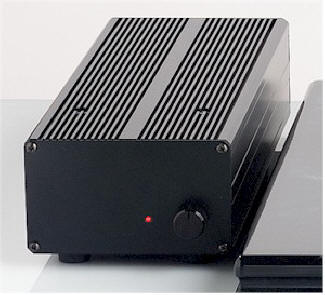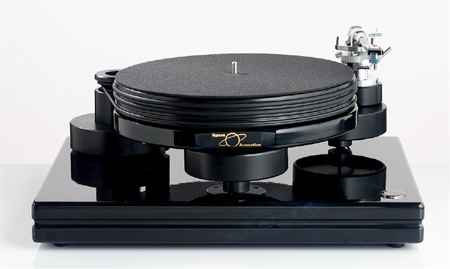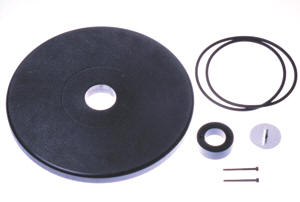
You are reading the older HTML site
Positive Feedback ISSUE
november/december 2007
nottingham
Wave Mechanic Power Supply Power Plant and Heavy Kit
as reviewed by Graham Abbott

|
GRAHAM ABBOTT'S SYSTEM
LOUDSPEAKERS
ELECTRONICS
SOURCES
CABLES
ACCESSORIES
|
My friends father-in-law worked as a heavy mechanic for many highly respected companies and whenever anyone asked him who makes the best stuff he would tell the tale of the two generators. One was from Japan and its build quality was of the 'lacquer box' variety, while the second was from Russia and ugly, brutish and full of squeaks, squawks and rattles from the proverbial day one. However, and I think you know where this is going, the Russian model required next to no TLC beyond simple routine maintenance and long after the first Japanese sample had packed it in, the Russian bear kept grinding away.
The Spacedeck is definitely more Russian than Japanese. There is nothing extraneous here, just sound engineering with a healthy dose of quality. For example, the tonearm has no finger-lift to avoid resonance and the tables low torque motor (it stays on all the time and just idles ever so gently when not in use) means you spin it manually to get it up to speed. Changing speeds is also manual, requiring a quick flip of the rubber belt between grooves on the pulley and platter. Where some tables scream bling the Space Deck screams I'll be here for a long time with its decidedly industrial finish. I've read a number of posts in various audiophile forums that describe this 'industrial' build quality in rather more profane terms but this misses the point from my perspective. Tom Fletcher has very definitive opinions on how the table should be made and what is in fact necessary to produce the best sound. When you buy a Spacedeck you don't get polish and flair. Instead you get a rugged platform with set and forget stability that makes records sound damn good. Period.

The Space is a very dynamic deck with great timing that gets right under your skin and stays there. Images are incredibly dense and solid and laid out on a wide deep sound soundstage just saturated with atmosphere. If musical flow is important to you then the Space Deck is a must hear as it does it better than most and many that are priced far beyond.
So where do you go from here? Well, if you own a Spacedeck, and 10,000+ of us apparently do, then you have options. The Wave Mechanic ($1599 US) is a fully rectified motor power supply that cleans up the incoming AC and sends the motor a pure, clean signal. Plug the motor into it, adjust the knob on the front and dial in the right frequency to get the table purring (Nottingham kindly include a strobe light and timing disc). I plugged my table into the WM over a month ago and the speed has never needed adjustment. The 'Heavy Kit' is an aptly named graphite composite platter that sits on top of the incumbent Space Deck unit. Nottingham supply an additional rubber ring that matches the other resonance reducing bands on the original platter and snaps into place between the two, making for a nice finished look.
When I plugged the Wave Mechanic in (I used the stock power cord that was included with the unit) and dialled in the frequency and checked it with the strobe, I was amazed by the music that poured forth. The Space Deck is not a reticent table in terms of pace and timing by any means, but now those same qualities were underlined by a new sense of order and clarity. The intervals between notes were better delineated imbuing the music with more transient energy and snap. And each instruments tonal signature really became distinct and more wholly developed. Along with the new leading edge transient energy came decay trails that seemed to linger forever and a heightened sense of air around each performer. The stock Spacedeck is no slouch picking up and transmitting ambient details, just that the new found pace and order of the music really allows details of all kinds to come through the mix.

After getting used to the Spacedeck Wave Mechanic combo I added the Heavy platter and here I want to digress for moment. When I first purchased my Spacedeck I did what any new owner does, I searched for the manual. To say I was surprised by the apparently hand drawn diagram of the 'table on a single page that was devoid of setup instructions is an understatement. The Heavy Kit package didn't even have the rough hewn sketch; in fact there was nothing at all included for either product. In Nottingham's defence, it isn't exactly rocket science to add either item, but still something would be nice. Simplicity does have some limits...
The Heavy Kit really surprised me. I use a Living Voice Mystic Mat and really felt that it had wrung most of the performance potential out of the stock deck (the Mystic Mat is expensive but really is a great product and a great match for the Spacedeck in particular). Everything about the sound is bigger; creating a huge acoustic envelope that defines instrument location and really delineates the distance between performers. The stock deck just doesn't communicate this sense of ambient headroom as well; the big platter seems to emphasize all the things that are good about analogue and none of the bad. I would love to hear this combo in a big room with some powerful tube electronics and big speakers because it would really flourish there; I think my Rosebud monitors really didn't allow it to stretch out fully.
So is it all gain? Mostly. What you do lose is some of the richness or saturated tonal colours or simple romanticism of the stock Space. What you get is a table that is still a romantic, but with a more precise and accurate, dare I say sophisticated sound. In particular, where the stock table slams densely articulated images into place, the modded table allows the recorded space to indicate instrument position, more along the lines of a live music experience. If your system leans to the cool or lean side of the spectrum then maybe the stock deck would add some juiciness but definitely at the expense of a more complete sonic environment.
And you're going to be out some cash for the two pieces. The Wave Mechanic retails for $1595 and the Heavy Kit at $1299. Add this to the base Spacedeck and you're looking at around $4700 bucks. Not exactly chump change but if you love the sound of your Spacedeck now then it's definitely a route to even better sound. Nottingham offers the Space 294 with a special platter and twelve inch arm for $3499 and the Hyperspace with an oil pumping bearing and heavy platter for $5499 but both come without the Wave Mechanic. Those with a taste for it all can opt for the Nottingham Dias that incorporates all the goodies in a design that moves away from the Space series aesthetics for $8499. I love my Spacedeck and combining it with a Wave Mechanic makes for a very formidable analogue rig that I could be very happy with for a long time. If I had a larger room with full range speakers and a fair amount of grunt then the Heavy Kit would be the icing on the cake. Graham Abbott
Wave Mechanic Power Supply
Retail: $1595
Heavy Kit
Retail: $1299
Nottingham
web address:
www.aslgroup.com
